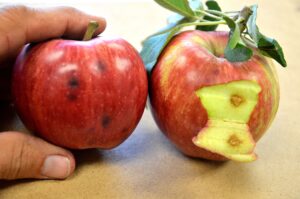Stink Bug Injury to Red Delicious: Management Should Begin Now.

 While rating our test plots for insect injury this morning, it became apparent that stink bug feeding that had occurred at least 2-weeks earlier, was appearing on the fruit. In many of our border plots along a wooded edge of the orchard we were seeing greater then 10% fruit injury.
While rating our test plots for insect injury this morning, it became apparent that stink bug feeding that had occurred at least 2-weeks earlier, was appearing on the fruit. In many of our border plots along a wooded edge of the orchard we were seeing greater then 10% fruit injury.
Cutting into the dark circular depressions of red delicious fruit we observed corking typical of stink bug feeding, with damage beginning at the skin surface and shallow entry, roughly 1cm into the flesh. During our evaluations we found adult BMSB in the trees along the orchard edge.
There is no distinction or visible difference in feeding injury on fruit caused by various stink bug species. During the period of July drought we had observed green stink bug in peach and apple. Now we are seeing BMSB migration into tree fruit YET adult trap numbers are well below threshold in all orchards where the insect is being monitored. At this point we are not certain if the damage was brought about by the July Drought or the low population of BMSB during the late season migration. In either situation management should begin.
At this point in time I would recommend making applications for BMSB management. By targeting the orchard blocks that have wooded border first, I would spray from the perimeter of the orchard into the block (a border application). As the concentration of injury will occur within 90′ along the wooded boarders, concentrating your efforts along the edge would be an economical and viable option for management of the BMSB at this time. If BMSB adults are found within the orchard, then alternate row middle or whole orchard applications are required.
At risk are the NY counties of Dutchess, Orange, Ulster and Columbia. Scouting in Red Delicious, Golden Delicious, and Honeycrisp should be ongoing through harvest.
If Bifenthrin has not yet been employed in your orchard (having a 30 re-treatment restriction) AND you have the ability to use it on susceptible varieties nearing harvest (14d PHI), then it would be the best option at this point in time.
The list of the most effective insecticides for BMSB management is found above. NYS labeled insecticides effective for use against the BMSB are available in four major classes including pre-mix formulations. Danitol is likely to be the best choice during the latter part of the season as its short pre-harvest interval and efficacy is a good fit. It is not as effective as Bifenthrin, however, it’s a very good choice for management of BMSB in peach as it has a 3-day PHI, strong efficacy, especially as a knock down insecticide, and also works well against the native stink bugs.
New York’s Section 18 application for the use of products containing bifenthrin has recently been approved by the EPA to control brown marmorated stink bug (BMSB). This is a renewal by the EPA and NYS DEC of a ‘Section 18 Emergency/Crisis Exemption Approval’ use permit for the pyrethroid bifenthrin to control brown marmorated stink bug on apples, peaches, and nectarines this year. Comparative efficacy studies in the lab and field have shown bifenthrin to be one of the most effective insecticides available against BMSB for use in NY State. Although this is an important tool for management of BMSB, the residual against this pest is relatively short lived, requiring vigilance in trapping and scouting 4 days post application.
In NYS its use is limited to Columbia, Dutchess, Orange and Ulster Counties.
Bifenthrin is a pyrethroid sold under the trade names of Brigade WSB (10% bifenthrin, EPA Reg. No. 279-3108, FMC Corp.), Bifenture EC (25% bifenthrin, EPA Reg. No. 70506-227), and Bifenture 10DF (10% bifenthrin, EPA Reg. No. 70506-227, United Phosphorus Inc.).
Labels specific for the Section 18 Exemption for bifenthrin use in NY can be found here:
Brigade WSB
Bifenture EC
Bifenture 10DF
Regardless of the product used, a maximum of 0.08 to 0.2 lb[AI]/acre/season will be allowed, with no more than 0.5 lb a.i./acre applied per year with multiple applications made at a minimum of 30 day intervals; a restricted entry interval (REI) of 12 hours and pre-harvest interval (PHI) of 14 days must be observed. When applying either of these materials for BMSB control on apples, peaches, or nectarines, growers must have possession of the Section 18 label.
